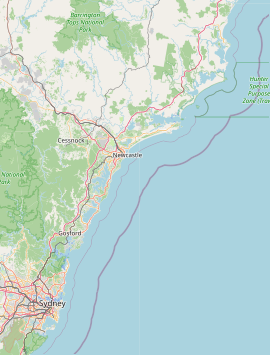Sandgate, New South Wales
Appearance
| Sandgate Newcastle, New South Wales | |||||||||||||||
|---|---|---|---|---|---|---|---|---|---|---|---|---|---|---|---|
 | |||||||||||||||
| Coordinates | 32°52′4″S 151°42′22″E / 32.86778°S 151.70611°E | ||||||||||||||
| Population | 276 (SAL 2021)[1] | ||||||||||||||
| Postcode(s) | 2304 | ||||||||||||||
| Area | 2.3 km2 (0.9 sq mi) | ||||||||||||||
| Location | 11 km (7 mi) NW of Newcastle | ||||||||||||||
| LGA(s) | City of Newcastle | ||||||||||||||
| Parish | Newcastle | ||||||||||||||
| State electorate(s) | Newcastle | ||||||||||||||
| Federal division(s) | Newcastle | ||||||||||||||
| |||||||||||||||
Sandgate is a suburb of Newcastle, New South Wales, Australia, located 11 kilometres (6.8 mi) from Newcastle's central business district. It is part of the City of Newcastle local government area. The Awabakal and Worimi people were the first to live in Newcastle.[2]
It has a railway station on the Hunter Line. Within the suburb is the largest cemetery in Newcastle, Sandgate Cemetery, which includes the now-derelict rail-head station, formerly used by funeral trains from Honeysuckle near Newcastle.
History
[edit]Sandgate was established in the early 20th century as a residential area when it underwent a development of housing estates during the expansion of the Newcastle area.
See also
[edit]References
[edit]- ^ Australian Bureau of Statistics (28 June 2022). "Sandgate (NSW) (suburb and locality)". Australian Census 2021 QuickStats. Retrieved 28 June 2022.
- ^ "Aboriginal Culture". City of Newcastle. Archived from the original on 13 June 2024.
The Awabakal and Worimi peoples are acknowledged by City of Newcastle as the Traditional Custodians of the land and waters situated within the Newcastle local government area, including wetlands, rivers creeks and coastal environments. It is known that their heritage and cultural ties to Newcastle date back tens of thousands of years.

